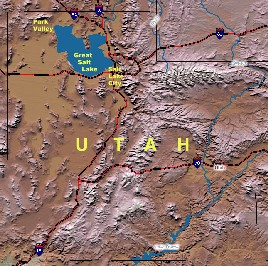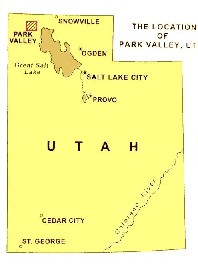Russian Colonists in the Utah Desert
Molokan Community in Utah — 1914 to 1918
| by Marshall E. Bowen,
Ph.D. Department of Geography Distinguished Professor of Geography (Emeritus) University of Mary Washington Fredericksburg, Virginia 22401 Phone: 540-654-1493 E-mail: dbowen@umw.edu |
This paper was presented April 10, 2003,
at the Association for Arid Lands Studies Western Social Science Association 26th Annual Conference, Las Vegas, Nevada Not all images were submitted. |
Click on Pictures to ENLARGE
AbstractThe dry plains of northwestern Utah are an unlikely place for agricultural settlement. But in the second decade of the twentieth century, Russian [Jumpers and] Molokans established a traditional agricultural village south of the town of Park Valley, and tried to farm here and at several additional sites within a few miles of the village. This paper identifies the forces that brought these people from Russia to California and then to Utah, describes their lives in this out-of-the-way place, explains why their endeavors failed, and tracks their movements as they made their way back to California. It suggests that dryland settlement patterns in the Great Basin were more complex than most scholars have realized, and calls attention to a distinctive ethno-religious element in the mosaic of life and landscape that evolved in this part of the American West. Fig. 1) State Highway 30 is northwestern Utah's main street, extending from the small town of Snowville to the Nevada state line. (Fig. 2) Thirty-five miles west of Snowville, Highway 30 passes through Park Valley, a hamlet that serves as the focal point for a small number of livestock ranches. (Fig. 3) From Park Valley, a gravel road runs southward to Dove Creek, an intermittent watercourse that disappears into the desert near Great Salt Lake. (Fig. 4) A mile north of Dove Creek, an unimproved section line road strikes off to the west.
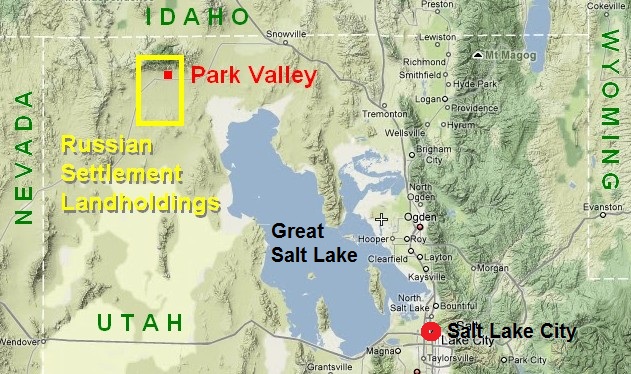 Park Valley terrian map showing Russian Jumper and Molokan Landholdings mapped below. Added by Conovaloff |
(Fig. 5) If a sharp-eyed visitor proceeds along this latter road for about two miles, he may spot a white picket fence off to the right, clearly out of place in this expanse of desert shrubs. (Fig. 6) Closer inspection shows that the fence encloses two graves, each with inscriptions carved primarily in Cyrillic letters. Nearby are foundations and other evidence that at some time in the past a number of people lived here and tried to farm. (Fig. 7) [map showing the location of Park Valley] Indeed, what the intrepid explorer will have come across are remnants left behind by Russian Molokans and Jumpers who occupied several parts of Park Valley during the second decade of the twentieth century. This paper traces the movement of these people from Russia to California, explains why some of them chose to move to Park Valley, describes certain aspects of their lives in this out-of-the-way place, and documents how they made their way back to California when the Utah experiment failed.
(Fig. 8) Molokans broke away from the Russian Orthodox Church in the eighteenth century over issues of use of icons, paid clergy, scriptural interpretation, church organization, and dietary restrictions. Their name is derived from the Russian word for "milk drinkers" because they refused to refrain from consuming dairy products during fasts, especially Lent. Opposition to the established state church, and to military service, led to their persecution and exile, first to the Volga River region and then to Transcaucasia. (Fig. 9) By the early 1900s more than 100,000 Molokans were residents of this area and neighboring parts of Russia. Some were merchants and others were artisans, but the largest number were peasant farmers, living in traditional linear "street villages" and tilling the surrounding lands. (Fig. 10) By this time the Molokans, like the Doukhobors to whom they are related, had divided into several distinct sub-groups. Among these, the most prominent were the Pryguny (known as "Spiritual Christian Jumpers" or simply "Jumpers"), who expressed their feelings of religious ecstasy by speaking in tongues, swaying, and jumping, and the Postoiannye (known as the "Steadfast' or Constant' Molokans), who did none of these things and denied the religious validity of the ecstasy which overcame the Jumpers. Despite their differences, the two groups remained on good terms, and intermarriage was neither unheard-of nor disapproved.
(Fig. 11) It was the Molokans' [and Jumpers'] unwavering stance against bearing arms that led to their migration to North America. The czarist government had granted Molokans exemption from military service in 1835, but this privilege was withdrawn in the last years of the nineteenth century, and when the Russo-Japanese War began and harassment for their non-combatant beliefs intensified, some of their number concluded that it was time to leave Russia. (Fig. 12) From 1905 to 1907 more than five thousand [about 3,000] Molokans [mostly Jumpers] fled to the United States, with the overwhelming majority ending up in California. (Fig. 13) About a thousand individuals, principally from the Steadfast [Molokan] group, settled in San Francisco, largely on Portrero Hill, South of the city's Central Business District. (Fig. 14) Most of the remainder, consisting largely of Jumpers, gravitated to Los Angeles, where they took up residence on the Flats, near the Los Angeles River just east of the city's Central Business District, in a neighborhood that in time came to be known as Russian Town.
(Fig. 15) In the early 1900s, the Flats, of which Russian Town was a part was a mixture of railroad tracks, factories and warehouses, and modest residences. Industrious and thrifty, many [Jumpers and] Molokans who settled here succeeded in purchasing their own homes within a few years of their arrival. They often rented parts of their houses to relatives, and if space permitted they also took in roomers, usually single [Jumper] Molokan men who had recently arrived in the city. According to the 1910 manuscript census, it was not unusual for more than a dozen men, women, and children to be crowded into a small bungalow, and in some cases the number of people living in a single house exceeded twenty. (Fig. 16) Most of the men were employed as laborers in lumber yards, iron works, and chair factories, while a very few had their own small businesses or worked as store clerks. (Fig. 17) Many [Jumper] Molokan women remained at home to care for their large families, but some, along with their teen-aged daughters, found work in nearby laundries.
(Fig. 18) Although they had achieved economic and political security, the [Jumpers and] Molokans were not satisfied with city living, and soon after their arrival in California many of them began searching for opportunities to obtain farms and resume the agrarian way of life that they had known in Russia. (Fig. 19) A desire to return to their rural roots was accentuated by concern that young [Jumpers and] Molokans were being exposed to undesirable American values, and that the best way to retain the group's culture was to move to remote areas where they could live in a traditional manner, unaffected by outside influences. (Fig. 20) Arrangements between [Jumper and] Molokan elders and land dealers soon led to the establishment of several rural colonies. In 1906 a farming community was founded in the Guadalupe Valley of Baja California, some fifty miles south of the United States border, and in the next few years others were begun near Glendale, Arizona, and in the San Joaquin Valley. (Fig. 21) Then, in 1914, other [Jumpers and] Molokans began considering moves to stiff more distant lands, including sites in eastern Washington and in northwestern Utah.
(Fig. 22) [Jumpers and] Molokans were lured to Park Valley by the efforts of the Pacific Land and Water Company, a firm based in Salt Like City, which had acquired more than thirty square miles of railroad land around 1910, and added to its holdings in the following years by absorbing the property of another land company and through purchase of smaller tracts from ranchers and other individuals. By early 1914 the firm had approximately 180,000 acres on the market (Fig. 23) The company was not modest in its advertising. Park Valley's soil, it declared, "is amongst the richest in the state of Utah, and ... only awaits the plow to yield up its vast treasures," while its climate was said to be "energizing," with more precipitation falling here than in some of the state's best dry fanning areas. (Fig. 24) Skeptics were assured that "the heavy growth of sagebrush is an indication of the bumper crops this land will produce." All this could be had, according to the company's advertisements, for $17.50 an acre, to be purchased with a twenty percent down payment and five yearly installments at seven percent interest.
(Fig. 25) In response to these glowing descriptions and the promises of a land agent who visited them in Los Angeles, a delegation of [Jumpers and] Molokans examined the company's Park Valley land in the spring of 1914. (Fig. 26) What they saw pleased them, for as the daughter of one delegate recalled, "everything was quite green [and] there seemed to be plenty of water." The visitors agreed that they "had a fine chance," and upon their return to California they recommended that interested families obtain land in the valley. (Fig. 27)[map of Molokan land holdings] With the help of a Los Angeles attorney who spoke Russian, a group of twenty [Jumper and] Molokan men agreed to purchase approximately four square miles of land extending from the vicinity of a low hill that became known as Russian Knoll to a point three miles to the northeast in some cases, it is said, deeding their homes in the city to the company to meet the cost of the down payment.
(Fig. 28) In April, 1914, approximately 100 Molokans, all from the Jumper branch of the religion, traveled by train [Southern Pacific RR] from Los Angeles to the small town of Kelton, twelve miles southeast of Park Valley, where they were met by a company employee who transported them by wagon to the foot of Russian Knoll. (Fig. 29)[map of Molokan land holdings] Here they laid out a fine village, similar in form to their home villages in Russia and to the new [Jumper] Molokan settlements in Mexico and Arizona, along an cast-west road near the southern edge of their property. Each village lot was a three-acre strip which had about 200 feet of frontage on the road and ran forty rods, or 660 feet, deep. (Fig. 30) More than a dozen families built houses, barns, and other outbuildings from rough lumber sawed at a company mill in the Raft River Mountains, a few miles to the north. A hand-dug well and a root cellar were ordinarily located a few feet from each house. (Fig. 31) Some men purchased horses and cattle from local farmers, and with the help of their fellow settlers, they began clearing desert shrubs and putting in crops. (Fig. 32)[map of Molokan land holdings] Meanwhile, other [Jumper and] Molokan families obtained land elsewhere in Park Valley. The largest cluster of homes was eight miles north of the Jumpers, village, where four Steadfast families purchased a quarter-section from the company near the village of Rosette. (Fig. 33) At this site, close to the Raft River Mountains, the families built modest houses, planted gardens and a small orchard, and kept a flock of geese which utilized a spring-fed pond near the north end of their property. (Fig. 34)[map of Molokan land holdings] Three additional families gathered on company land west of the village, just south of Dove Creek. Three homestead sites were also claimed by Molokans who had bought company land, but there is no sure evidence that any of these parcels became their places of residence.

(Fig. 35) Once their new homes were completed, the [Jumpers and] Molokans made every effort to resume normal family and community life. (Fig. 36) Within little mom than a year of their arrival in Park Valley, they welcomed the birth of at least eight children, while several others were born in subsequent months. Most [Jumper and] Molokan women delivered just one child during their years in this remote place, but Nadejda Karyakin, wife of Alex, had two daughters about a year apart, while Dunia Potapoff, wife of Ivan, bore a daughter in May, 1915, and a son sixteen months later. In one unusual case, Susan Valoff, a young Molokan girl, married Dmitri Bulvan, member of a colony of non-Molokan Russians also living in Park Valley, and in 1916 the couple was blessed with their first child, a son whom they named Vladimir. (Fig. 37) Upon their arrival in Utah, Molokan children had more than a year without any schooling, but in August, 1915, when the number of school-age youngsters living near Russian Knoll had reached forty, Box Elder County established what was called the "Russian School" on a two-acre plot near the northwestern edge of the village, and hired a teacher. To the north, a small number of children from the cluster of Steadfast families attended school in Rosette, "with the Mormons," as one family member put it.
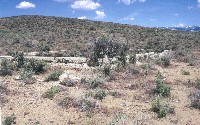 Fig. 37. The foundation of the "Russian School", operated by Box Elder County during the 1915-1916 school year, situated just northwest of the village at the foot of Russian Knoll, which rises in the left background. The mountains in the far right background are the Raft River Mountains. |
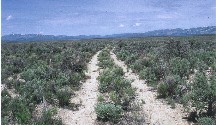 Fig. 39. This is the unimproved section line road that served as the main street of the Molokans’ village. The picture, looking west, was taken a short distance west of the village itself and just southwest of Russian Knoll. |
(Fig. 38) Neither group of Molokans [or Jumpers] built a church structure [prayer house], but from the very start they held religious services in some of the larger homes. Each group celebrated holidays, such as Passover [for Jumpers] and Pentecost, as best they could, and on some special occasions (Fig. 39) the Steadfast families would travel down this road to the village for church services, feasts, and other social activities. (Fig. 40) "We went [down there] and saw them jump" several times, recalled this woman, who as a young girl lived with her parents and two sisters in the Steadfast [Molokan] cluster near Rosette.
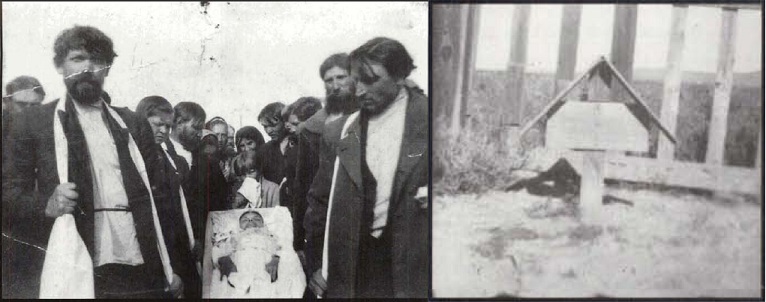
Funeral of Mary Kalpakoff, February 1915, and her original gravemarker.
(Fig. 41) Unfortunately, these good times were overshadowed by tragedy and disappointment. The first occurred only a month after the first colonists arrived, when Andrew Kalpakoff accidentally shot and killed his wife, Anna. Less than a year later, Mary Kalpakoff, the wife of Andrew's brother, Mike, died in childbirth. After her funeral, shown here, Mary was buried a short distance east of the village and the body of Anna, which had originally been interred in the Mormon cemetery in Park Valley, was brought to the colony and placed in a grave next to that of her sister-in-law. (Fig. 42) Mike Kalpakoff and his father, a 65-year-old man who was the community's oldest resident, erected grave markers and built this fence around them. Today, nearly ninety years later, the fence is still standing, and now encloses two modem gravestones placed at the site by Mike's son in 1966.
(Fig. 43) Although these events brought despair to the colony, in the long run they could not compare to the disastrous effects of crop failure. June of 1914 was pleasantly moist, with eight days when precipitation was recorded. The rain, totaling nearly three inches, provided hope for the future, but the future in fact proved bleak.. For as long as the Molokans [and Jumpers] remained in Park Valley, annual precipitation never reached ten inches, and crops failed with regularity. (Fig. 44) The company had told purchasers that they could obtain irrigation water from wells, but this was not forthcoming, and the Molokans [and Jumpers] living near Russian Knoll were forced to rely exclusively on dry farming methods, taught to them by the company's so-called "farming expert," based at this site four miles from their village. But whatever knowledge they absorbed was never enough to overcome the dry weather and hot summer winds. (Fig. 45) Then, to further confound them, occasional sudden, heavy rains did more harm than good. (Fig. 46) One former resident of the village recalled that "terrific sandstorms covered up the fields two and three feet deep. And after a sand storm, cloudbursts soaked the fields to the point where everything rotted in the ground." (Fig. 47) In short order, conditions became desperate. Andrew Kalpakoff and Oseff Potapoff each managed to borrow $400 in the summer of 1915, putting up their horses and some cows as collateral, to try to keep the colony going, but it was not enough to offset the deplorable situation that they faced.
(Fig. 48) The Steadfast [Molokan] families living near Rosette had better luck with their crops, probably because more water was available closer to the mountains, but they faced problems of another sort. (Fig. 49)[map of Molokan land holdings] Although they got along well with the Jumpers at the village, and visited them several times each year, these people longed for a stronger Steadfast [Molokan] presence in the area. When it became clear that no more families of their particular faith would be arriving, and that a full-fledged Steadfast [Molokan] community would never develop in Park Valley, they began to talk seriously about giving up and returning to California. (Fig. 50) Ivan Potapoff and his family had worked hard to develop their farm, remembers his daughter, but for Ivan and his immediate neighbors, having a good farm was not enough. There was more to life, he said, than tilling the soil.
 Fig. 51. The foundation of the "Russian School", operated by Box Elder County during the 1915-1916 school year, situated just northwest of the village at the foot of Russian Knoll, which rises in the left background. The mountains in the far right background are the Raft River Mountains. |
(Fig. 51) Departures from Park Valley began in late 1915. By November of that year, enrollment at the Russian School had dropped so much that the county considered closing all Classes did continue until spring, but in the fall of 1916 the building was taken from its foundations, shown here, and moved to another dry farming area, some forty miles distant, where there was a greater need for it. (Fig. 52) Most families returned to California, with the vast majority going to Los Angeles, but there were notable exceptions. Ivan Potapoff and family moved to San Francisco, where they were absorbed by the Steadfast [Molokan] community on Portrero Hill. For about a year they lived in this house. (Fig. 53) Alex and Mary Rudometkin, who had lived west of the village, made their way to the Molokan [Jumper] community near Glendale, Arizona, where the couple welcomed their first child in the fall of 1916. Here, they lived close to Pete and Fannie Volkoff and their three children, who had also been residents of Park Valley before moving to Arizona (Fig. 54) At least five families went to Salt Lake City, where they remained for a year or two before returning to California. Most of these men and their older sons worked as teamsters and laborers, while their teen-aged daughters found employment in food processing plants. (Fig. 55) The last Molokan [or Jumper] family left Park Valley in 1917, and little more than a year later Nick and Julia Chernabaeff and their two children, who were the last of their people to live in Salt fake City, went back to California.
(Fig. 56) By 1920 nearly all former residents of the Molokan [and Jumper] settlements in Park Valley were once again living in California. The majority had resumed living in Los Angeles' Russian Town, in many cases literally within sight of the homes they had left when they moved to Utah. Here, a number of men once again found employment in lumber yards, and their wives and daughters went back to work in the city's laundries. (Fig. 57) Many lived in this neighborhood for the rest of their lives. (Fig. 58) At least five others, however, had responded to the Molokan [and Jumper] ideal of an agrarian life, and now made their homes on rented farms, with three of them living in what was then rural Los Angeles County.(Fig. 59) John Chemabaeff had relocated to a dairy farm in the Central Valley, where he employed his son, Nick, and one of the Kalpakoff boys to care for a herd of forty milking cows.(Fig. 60) After a short period of residence in San Francisco, the Ivan Potapoff family had also returned to their rural roots, and in 1920 they were living in Santa Rosa County, near the homes of several other Steadfast farmers, including Mr. Potapoff’s cousin.
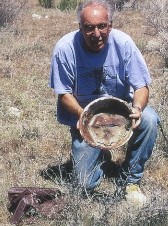 Fig. 67. A couple of rusty old utensils (and Dr. Bowen) near a house site just north of the village street. |
(Fig. 61) Since the Molokans' [and Jumpers'] departure from Park Valley, no one has lived at any of the sites that they occupied. Some of their buildings remained standing for decades, and (Fig. 61-A)[aerial photo taken by the USDA in 1966 that shows the village lots near Russian Knoll] as recently as the 1960s it was still possible to identify the distinctive pattern of village lots near Russian Knoll. Today, the remnant landscape is less visible. (Fig. 62) At the Steadfast [Molokan] settlement near Rosette, the pond where the Molokans' geese once swam, now greatly modified by a rancher for watering his cattle, still exists, while nearby (Fig. 63) are parts of a bed that was left behind. (Fig. 64) More evidence remains at the village site, where abandoned fields stand in stark contrast to desert shrublands, (Fig. 65) where clearly-defined foundations and (Fig. 66) caved-in wells are numerous, and (Fig. 67) where it is still possible to discover household utensils, ranging in size from pots and pans (Fig. 68) to an old rusty spoon. (Fig. 69) The graves of the Kalpakoff women are the most immediately visible remnants. On the one hand, they symbolize the failure of these Russian peasants to establish a viable community in a remote part of the American West. (Fig. 70) On the other, the graves serve as reminders that dryland settlement of the Great Basin in the early twentieth century involved more ingredients than most scholars have realized, and that we should look carefully for additional evidence of ethno-religious groups who invaded this harsh land, and tried to recreate traditional patterns of life, livelihood, and landscape.
The most important secondary sources, used principally for background information, are:
- Sarah Yates. "From Dust to Dust: A Russian Sojourn" Beehive
History, Volume 25
(1999) pp 14-17. This paper was presented April 20, 2000, during the
noon "Utah
History
Brown
Bag Series" by the Utah State Historical Society,
Utah State Archives, Salt Lake City, Utah.
- John K. Berokoff, Molokans in America. Whittier, CA: Stock-ton-Doty Trade Press, 1969.
- Susan W. Hardwick, "Religion and Migration: The Molokan Experience," Yearbook of the APCG 55 (1993): 127-141.
- George W. Mohoff and Jack P. Valov, A Stroll Through Russiantown. Los Angeles: Privately Published, 1996.
- Pauline V. Young, The Pilgrims of Russian-Town. Chicago: University of Chicago Press, 1932.
- U.S. Census of Population manuscript schedules for 1910 and 1920,
- city directories for Los Angeles, San Francisco, and Salt Lake City,
- tax assessment rolls for Box Elder County, Utah,
- genealogies prepared by several Jumper and/or Molokan families,
- a diary (in Russian) kept by Mike Kalpakoff from 1905 to 1932,
- several letters (in English) written by Jumpers and / or Molokans who either lived in Park Valley or were close relatives of people who lived there, and
- a number of interviews, including one conducted just a year ago with an elderly but mostly sharp woman who lived in the Steadfast cluster with her parents, Ivan and Dunia Potapoff.
